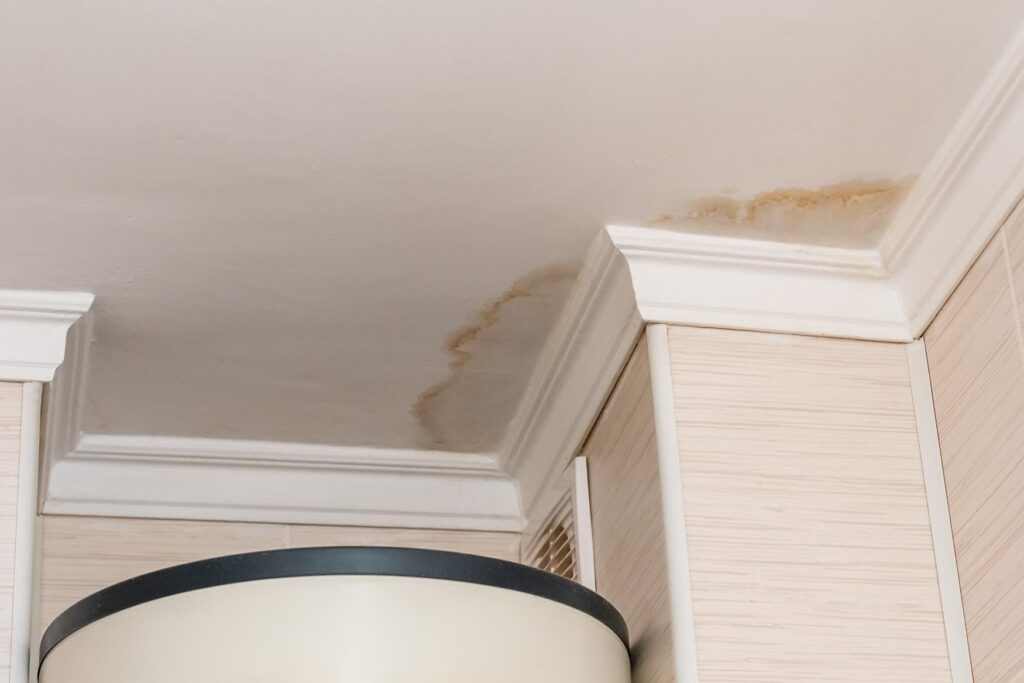
Contents
When water damage strikes, acting fast can save you time and money. You’ll want to quickly assess the situation and gather the right tools to tackle the problem efficiently. Removing standing water is essential, and you can do this with a wet/dry vacuum or by mopping up excess moisture. From there, drying out your home effectively will be key. But how do you ensure you tackle all potential issues, including mold and future leaks?
Key Takeaways
- Identify the water source quickly to prevent further damage and reduce repair costs.
- Use a wet/dry vacuum and fans to remove water and enhance drying without professional help.
- Create a DIY mold removal solution using vinegar or baking soda for minor mold issues.
- Regularly inspect your plumbing and appliances to catch leaks early and avoid extensive damage.
- Seal foundation cracks and maintain drainage systems to prevent future water damage efficiently.
Assessing the Damage Quickly
As soon as you notice water damage, it’s important to act quickly to minimize further issues. Start by identifying the water source—whether it’s a leaky pipe, a roof leak, or flooding. This step is vital for effective damage evaluation.
Once you pinpoint the source, turn off the water supply to prevent more damage.
Next, assess the extent of the damage. Check walls, ceilings, and floors for signs like discoloration, warping, or mold growth.
Don’t forget to examine hidden areas, such as behind appliances or inside cabinets, where moisture may linger.
Take notes and photos for your records; they’ll help you when discussing repairs with professionals or your insurance company.
Gathering Essential Tools and Supplies
Having the right tools and supplies on hand can make a significant difference when tackling water damage restoration. Proper tool selection and efficient supply sourcing are vital steps in your restoration process.
Start by gathering essential items that can help you address the situation effectively and affordably.
- Wet/dry vacuum: Perfect for removing standing water quickly.
- Dehumidifier: Helps reduce humidity and prevent mold growth.
- Mold-resistant cleaning products: Essential for ensuring a safe, clean environment.
Investing in these items doesn’t have to break the bank. Look for budget-friendly options at local hardware stores or consider borrowing from friends or neighbors.
Prioritizing Immediate Water Removal
Once you’ve gathered your tools and supplies, the next step is to focus on immediate water removal. Effective water extraction is essential to prevent further damage and reduce the risk of mold growth.
Start by using a wet/dry vacuum to remove standing water from floors and surfaces. If you don’t have one, consider borrowing from a neighbor or renting one—it’s a great way to foster community ties while addressing your emergency response.
Don’t forget to mop up any excess water, paying close attention to corners and crevices where water tends to accumulate. If you notice water pooling in rugs or carpets, roll them up and extract water as best as you can.
Acting quickly protects your home and brings peace of mind. Remember, the sooner you tackle water removal, the easier it’ll be to restore your space and create a sense of normalcy again.
Drying Out Affected Areas
To effectively dry out affected areas, you’ll want to act swiftly and methodically to minimize damage and prevent mold growth.
Start by using moisture measurement tools to assess the level of dampness on various surfaces. This will guide your drying efforts.
Next, implement air circulation techniques to enhance evaporation. You can do this by:
- Opening windows and doors to create cross-ventilation
- Using fans strategically to direct airflow toward wet areas
- Running a dehumidifier to extract excess moisture from the air
These methods will help you achieve ideal drying results.
Remember, the quicker you dry out the space, the less likely you’re to face long-term damage. Stay vigilant and check your progress regularly, adjusting your techniques as needed.
Checking for Mold Growth
After drying out the affected areas, it’s essential to check for signs of mold growth.
Look for dark spots, a musty odor, or any discoloration on walls and ceilings, as these can indicate a mold problem.
If you find any, knowing effective removal techniques can help you tackle it before it worsens.
Identify Signs of Mold
How can you quickly spot the signs of mold growth in your home?
Start by checking areas prone to moisture levels, like bathrooms, basements, and kitchens.
Look out for these indicators:
Visible Mold: Dark spots or fuzzy patches on walls or ceilings.
Musty Odor: A persistent, earthy smell often signals mold presence.
Water Damage: Stains or discoloration on surfaces can indicate moisture issues.
Effective Mold Removal Techniques
Effective mold removal starts with a thorough assessment of the affected areas. You’ll want to check for visible mold growth and moisture sources. After identifying the problem, use safe cleaning techniques to remove mold. Here’s a quick guide to help you:
| Step | Action |
|---|---|
| Inspect | Look for water damage & mold |
| Contain | Seal off affected areas |
| Clean | Use vinegar or baking soda |
| Assess | Evaluate for mold prevention |
Salvaging Personal Belongings
When water damage strikes, your first step should be prioritizing your most valuable items to ensure they receive immediate attention.
Act quickly to clean and dry these belongings, as time is vital in preventing further damage.
Finally, assess the overall damage thoroughly to determine what can be salvaged and what needs to be replaced.
Prioritize Valuable Items
As you assess the damage from water intrusion, it’s crucial to prioritize valuable items to maximize your chances of salvaging them.
Start by creating an essential belongings checklist, focusing on items that hold significant monetary or sentimental value. Conduct a valuable item assessment to determine what you need to rescue first.
Consider these key items:
- Important documents (passports, birth certificates)
- Electronics (computers, tablets)
- Heirlooms or collectibles (family jewelry, antiques)
Clean and Dry Quickly
After prioritizing your valuable items, the next step is to act swiftly to clean and dry everything affected by water.
Start by using effective cleaning techniques for different materials—soft fabrics may require gentle soaps, while hard surfaces benefit from disinfectants. Rinse items thoroughly to remove contaminants.
For drying methods, utilize fans and dehumidifiers to expedite the process. If possible, take wet items outside to air dry in sunlight, which can also help eliminate odors.
Don’t forget to check hidden areas, as moisture can linger and lead to mold growth. The quicker you address these issues, the better your chances are of salvaging your belongings and minimizing further damage.
Time is of the essence!
Assess Damage Thoroughly
While evaluating the damage, it’s crucial to take a systematic approach to salvaging your personal belongings. Start by employing effective damage evaluation methods, ensuring you don’t overlook any affected items. Use visual inspection techniques to identify water damage on surfaces, fabrics, and electronics.
Consider these key steps to maximize your efforts:
Categorize items: Separate belongings into salvageable, questionable, and irreparable piles.
Assess materials: Determine the material type, as some items are more susceptible to damage than others.
Document everything: Take photos and notes for insurance claims and future reference.
Repairing Minor Damage Yourself
Many homeowners face minor water damage at some point, and you can often tackle these repairs yourself without breaking the bank.
Start by evaluating the affected area; look for signs like discoloration or peeling paint. For small leaks, DIY repairs like sealing cracks with caulk or replacing damaged drywall can be straightforward. When estimating costs, consider materials like caulk, paint, or drywall, which are usually affordable at your local hardware store.
If you need to dry out an area, fans and dehumidifiers can be rented at low costs.
Remember to document your repairs; this helps you track expenses and prepares you for any future issues. Engaging in these DIY efforts saves money and gives you a sense of accomplishment.
When to Call in Professionals
Knowing when to call in professionals for water damage restoration can save you time, money, and further complications.
It’s vital to be proactive and recognize warning signs that indicate a more significant issue at hand. If you find yourself in any of the following situations, it’s wise to seek help:
Extensive water damage: When water has affected large areas or structural elements of your home.
Mold growth: If you see mold or smell mustiness, professional remediation is necessary to ensure health and safety.
Electrical hazards: If water has compromised electrical systems, don’t hesitate to call an expert.
Knowing your limits is key.
While DIY solutions can work for minor issues, don’t risk your well-being or your home’s integrity.
Trust professionals to handle the heavy lifting, allowing you to focus on recovery and moving forward.
Preventing Future Water Damage
After addressing immediate water damage issues, it’s time to focus on safeguarding your home against future incidents.
Start by investing in effective waterproofing solutions. This could involve sealing cracks in your foundation and applying waterproof paint to your basement walls. These steps can greatly reduce moisture intrusion.
Next, pay attention to your drainage systems. Verify gutters and downspouts direct water away from your home. Regularly clean them to prevent clogs that can lead to overflow.
Consider installing a French drain to further manage water flow around your property.
Lastly, check your appliances and plumbing regularly for leaks. A proactive approach will save you time and money in the long run.
Final Thoughts
Now that you’ve tackled the immediate aftermath of water damage imagine standing in your dry, restored space, free from the worry of mold lurking in corners. You’ve turned the tide on potential disaster by acting swiftly and using simple tools. But don’t let your guard down; keep inspecting and maintaining your home. With each proactive step, you’re protecting your belongings and transforming your living space into a fortress against future water threats. Stay vigilant!
Recent Posts
Bounce Back: Flood Cleanup and Mold Busters
It’s vital to act quickly and effectively after a flood. Understanding the right steps and
Key Tips for Flood Cleanup and Mold Prevention
After a flood, you’re faced with the critical task of cleanup and mold prevention. It’s
7 Best Flood Cleanup and Mold Prevention Tips
Many people underestimate the speed at which mold can develop after a flood, often within
